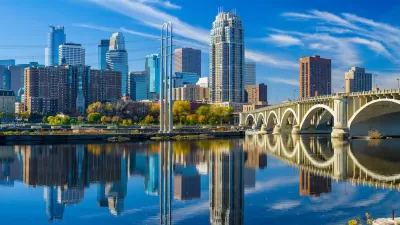Included in the 2005 federal transportation bill was $100 million for four regions to invest in bike and pedestrian infrastructure to determine, essentially, if they build it, will they bike and ride more and drive less. The final results are in.
The Federal Highway Administration Bike/Walk Pilot pilot program, authorized by the 2005 federal transportation reauthorization bill known as SAFETEA-LU shows conclusively that infrastructure investments increase bicycle and pedestrian mode share of trips.
The Nonmotorized Transportation Pilot Program (NTPP) "provided over 25 million dollars each to four communities to demonstrate how improved walking and bicycling networks can increase rates of walking and bicycling. FHWA was required to report on the results of the NTPP. An Interim Report was submitted to Congress in January 2008. A Final Report was submitted in April 2012."
For each region, partner agencies were chosen to administer the grant funds:
- Columbia, Missouri; via GetAboutColumbia
- Marin County, California; via Walk-Bike Marin
- Minneapolis, Minnesota; via Bike Walk Twin Cities
- Sheboygan County, Wisconsin via the county planning dept.
Smart Mobility, a project of the Rails to Trails Conservancy, that worked with FHWA added that "the Pilot is designed to demonstrate that bicycling and walking can represent a major part of an affordable, sustainable transportation solution."
Key outcomes of the NTPP described in this report [PDF] include:
- Counts in the four pilots saw an average increase of 49 percent in the number of bicyclists and a 22 percent increase in the number of pedestrians between 2007 and 2010.
- Mode share increases in the pilot communities to bicycling and walking and away from driving from 2007 to 2010 outpaced the national average from 2001 to 2008.
- For the communities in sum, bicycling mode share increased 36 percent, walking mode share increased 14 percent, and driving mode share decreased 3 percent between 2007 and 2010.
Thanks to Greenwire
FULL STORY: National Bike Month, a good time to put on your helmet and saddle up

Planetizen Federal Action Tracker
A weekly monitor of how Trump’s orders and actions are impacting planners and planning in America.

Restaurant Patios Were a Pandemic Win — Why Were They so Hard to Keep?
Social distancing requirements and changes in travel patterns prompted cities to pilot new uses for street and sidewalk space. Then it got complicated.

Map: Where Senate Republicans Want to Sell Your Public Lands
For public land advocates, the Senate Republicans’ proposal to sell millions of acres of public land in the West is “the biggest fight of their careers.”

Maui's Vacation Rental Debate Turns Ugly
Verbal attacks, misinformation campaigns and fistfights plague a high-stakes debate to convert thousands of vacation rentals into long-term housing.

San Francisco Suspends Traffic Calming Amidst Record Deaths
Citing “a challenging fiscal landscape,” the city will cease the program on the heels of 42 traffic deaths, including 24 pedestrians.

California Homeless Arrests, Citations Spike After Ruling
An investigation reveals that anti-homeless actions increased up to 500% after Grants Pass v. Johnson — even in cities claiming no policy change.
Urban Design for Planners 1: Software Tools
This six-course series explores essential urban design concepts using open source software and equips planners with the tools they need to participate fully in the urban design process.
Planning for Universal Design
Learn the tools for implementing Universal Design in planning regulations.
Heyer Gruel & Associates PA
JM Goldson LLC
Custer County Colorado
City of Camden Redevelopment Agency
City of Astoria
Transportation Research & Education Center (TREC) at Portland State University
Camden Redevelopment Agency
City of Claremont
Municipality of Princeton (NJ)




























